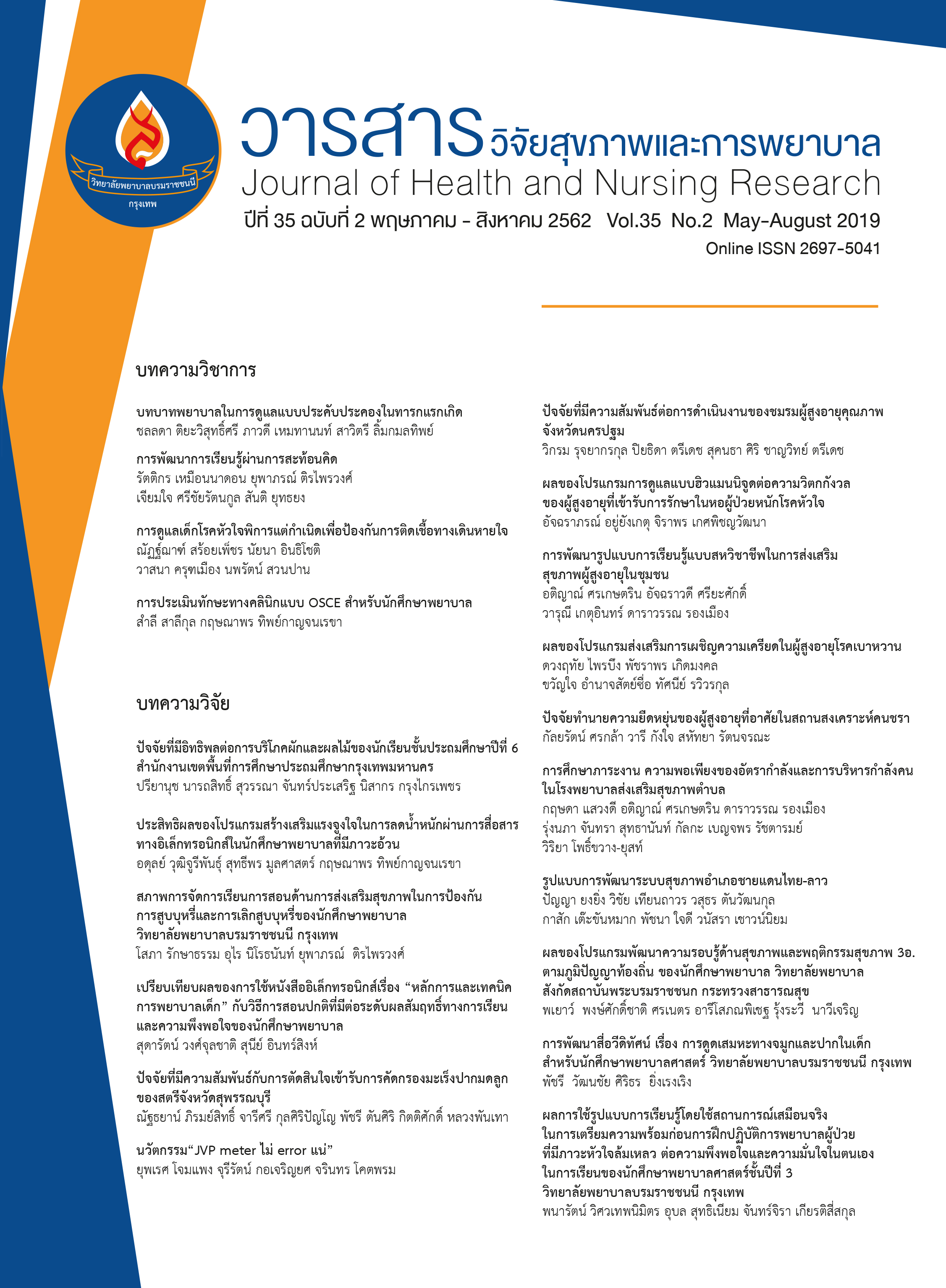ปัจจัยที่มีอิทธิพลต่อการบริโภคผักและผลไม้ของนักเรียนชั้นประถมศึกษาปีที่ 6 สำนักงานเขตพื้นที่การศึกษาประถมศึกษากรุงเทพมหานคร
คำสำคัญ:
การบริโภคผักและผลไม้, เด็กวัยเรียน, กรุงเทพมหานครบทคัดย่อ
การบริโภคผักและผลไม้เป็นปัจจัยสำคัญที่ช่วยส่งเสริมการเจริญเติบโตและพัฒนาการตามวัยของเด็กวัยเรียน การวิจัยครั้งนี้มีวัตถุประสงค์เพื่อศึกษาพฤติกรรมการบริโภคผักและผลไม้ และปัจจัยที่มีอิทธิพลต่อการบริโภคผักและผลไม้ของนักเรียนชั้นประถมศึกษาปีที่ 6 สำนักงานเขตพื้นที่การศึกษาประถมศึกษากรุงเทพมหานคร กลุ่มตัวอย่าง คือ นักเรียนชั้นประถมศึกษาปีที่ 6 ปีการศึกษา 2560 จำนวน 185 คน โดยการสุ่มตัวอย่างแบบหลายขั้นตอน เครื่องมือที่ใช้ในการเก็บรวบรวมข้อมูลเป็นแบบสอบถาม ประกอบด้วย ข้อมูลทั่วไป ความรู้เรื่องผักและผลไม้ ทัศนคติต่อการบริโภคผักและผลไม้ การเข้าถึงแหล่งที่เอื้อต่อการบริโภคผักและผลไม้ อิทธิพลของผู้ปกครอง อิทธิพลของกลุ่มเพื่อน การได้รับข้อมูลข่าวสารเกี่ยวกับผักและผลไม้ และการบริโภคผักและผลไม้ของนักเรียน วิเคราะห์ข้อมูลโดยใช้สถิติพรรณนา และการวิเคราะห์ถดถอยพหุคูณแบบขั้นตอน
ผลการวิจัย พบว่า นักเรียนบริโภคผักและผลไม้สัปดาห์ละ 4-6 วัน ปัจจัยที่สามารถร่วมทำนายการบริโภคผักและผลไม้ของนักเรียน (FVC) อย่างมีนัยสำคัญทางสถิติ (p < .001) คือ การจัดเตรียมอาหารของผู้ปกครอง (PPP) (β = .376, p < .001) รองลงมา คือ การได้รับข้อมูลข่าวสารเกี่ยวกับผักและผลไม้ (INF) (β = .286, p < .001) และทัศนคติต่อการบริโภคผักและผลไม้ (ATT) (β = .171, p < .01) อำนาจการทำนายร่วมร้อยละ 31.8 (R 2 = .318) โดยค่าคงที่ไม่มีนัยสำคัญในสมการทำนาย และสามารถเขียนสมการทำนายได้ ดังนี้
FVC = 0.298 (PPP) + 0.244 (INF) + 0.188 (ATT)
ผลการวิจัยนี้เสนอแนะว่า การส่งเสริมให้เด็กวัยเรียนบริโภคผักและผลไม้ ควรเน้นการจัดเตรียมผักและผลไม้เพื่อให้เอื้อต่อการบริโภค การให้ข้อมูลข่าวสาร ตลอดจนส่งเสริมทัศนคติที่ดีต่อการบริโภคผักและผลไม้
Downloads
เอกสารอ้างอิง
2. Kongkachuichai R, Charoensiri R. Vegetable and Nutrition. Bangkok: Sarakadee; 2011. (in Thai)
3. Kongkachuichai R, Charoensiri R. Fruit and Nutrition (Update Version). Bangkok: Sarakadee;2015. (in Thai)
4. Butryee C. Increasing Vegetable and fruit consumption. Bangkok: Printing house for The War Veterans Organization of Thailand; 2012. (in Thai)
5. Aekplakorn W, Mosuwan L, Ruangdaraganon N, Chanarong P, Sangsupawanich P, Satheannoppakao
W, et al. Report for Thai Health Survey on Physical Examination, 4th Time 2008-2009
[Internet]. 2009 [cited 2018 Mar 1]. Available frohttp://www.hisro.or.th/main/download/NHES4_
CHILD.pdf (in Thai)
6. Committee of Food-Consumption Guideline for Healthy Thai. Manuals for Nutritional Flag, Proper
Eating for Happiness of Thailand. Bangkok: Printing House for Department of Land Transport; 2009. (in Thai)
7. Policies and Plan for Office of Educational Service Area, Bangkok. Schools and Children in the
Office of Educational Service Area, Bangkok [Internet]. 2017 [cited 2018 Mar 1]. Available from
http://www.planbkk.com/mainpage (in Thai)
8. Chaingkuntod S, Muttawangkul C, Chancharoen K, Hongkrailert N, Romnukul N, Udomsri T, et al.
Knowledge and Behavior on Food Consumption of Pasi Charoen Persons. Bangkok: Research
center for community development, Siam university; 2014. (in Thai)
9. Klinkulab C, Srisuriyawet R, Homsin P. Factors Predicting Fruit and Vegetable Consumption among
Grade 6 Primary School Students in Pa Mok District, Ang Thong Province. The Public Health
Journal of Burapha University 2014;9(2):45-55. (in Thai)
10. Wannasri S, Therawiwat M, Imamee N, Chongsuwat R. Fruit and Vegetable Dietary Behaviors in
Elementary School Students, Surat Thani Province, Thailand. Journal of Health Education
2013;36(124):45-60. (in Thai)
11. Green LW, Kreuter MW. Health promotion planning: An education and environment approach.
NewYork: McGrau Hill; 2005.
12. Pengprom K. Household Fruits Availability and Consumption of Junk Food Among Students Grade
7-9 in Bangkok. Thesis in Master of Science, Major in Nutrition and Dietetics, Faculty of Public
Health, Mahidol University; 2008. (in Thai)
13. Eiumsa-ad P. Consuming behaviors in the grade 3 students in Arunpradit school, Mueang district,
Phetchaburi province. Thesis in Master of Science, Major in Health Education, Faculty of Physical
Education, Kasetsart University; 2009. (in Thai)
14. Pichairat A, Tiparat W. Effect of Health Alliance Program on Food Consumption and Exercise
Behaviors, and Weight of Obese School Age Children in Rural Area, Trang Province. The Journal
of Boromarajonani College of Nursing, Bangkok 2014;20(3):64-76. (in Thai)
15. Food and Nutrition Policy for Health Promotion. Complete Report for The Survey Campaign
of Food Environmental in School, Around School, and Study of Food-Consumption Behavioral
of School-Age Children and Related Factors, Stage 1 [Internet]. 2007 [cited 2018 Mar 1]. Available
from http:// www. fhpprogram.org/media/pdfs/reports/731cf5a3df094a7ed786bdb5d19c83df.pdf
(in Thai)
16. Chaiyasung P, Yakasem P, Chuthongrat N. Factors Predicting Food Consumption Behaviors of
Overweight Elementary School Students, Grade 4-6. The Journal of Boromarajonani College of
Nursing, Nakhonratchasima 2014;20(1):30-43. (in Thai)
17. Tabachnick BG, Fidell LS. Using multivariate statistics. 5th ed. Boston: Allyn & Bacon; 2007.
18. Bloom BS. Handbook on formative and summative evaluation of student learning. New York:
McGraw-Hill; 1971.
19. Katesing W. Mean for Meaning, The Easy That’s Not Easy. News for Educate Research 1995;1(4):13. (in Thai)
20. Sawasdee S, Wimolwatwetee T, Viratsetsin K. Snack Consumption Behavior of Students at High
Schools in Wattana Districts, Bangkok. Vajira Nursing Journal 2007;9(1):1-11. (in Thai)
21. Nithitantiwat P, Udomsapaya W. Food Consumption Behavior among Thai Adolescents, Impacts,
and Solutions. Journal of Phrapokklao Nursing College, Chantaburi 2017;28(1):122-8. (in Thai)
ดาวน์โหลด
เผยแพร่แล้ว
รูปแบบการอ้างอิง
ฉบับ
ประเภทบทความ
สัญญาอนุญาต
บทความที่ได้รับการตีพิมพ์ เป็นลิขสิทธิ์ของวารสารวิจัยสุขภาพและการพยาบาล (วิทยาลัยพยาบาลบรมราชชนนี กรุงเทพ) ไม่สามารถนำไปตีพิมพ์ซ้ำในวารสารฉบับอื่น


















